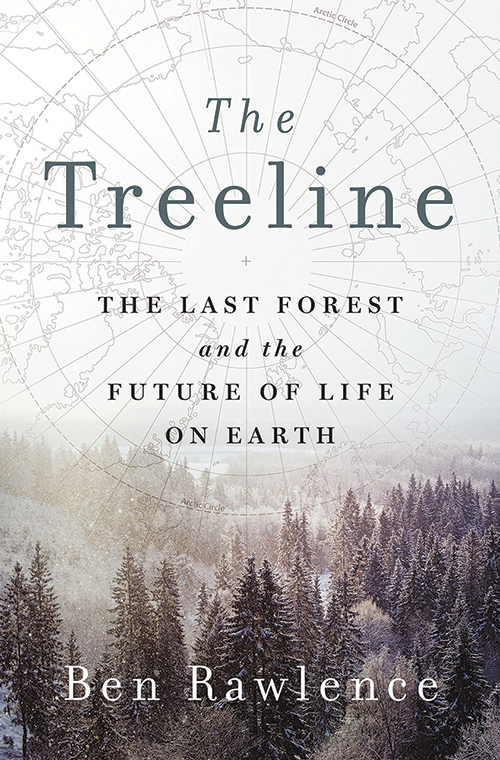
The Treeline: The Last Forest and the Future of Life on Earth
Reviewed by Ruah Swennerfelt
February 1, 2023
By Ben Rawlence. St. Martin’s Press, 2022. 320 pages. $29.99/hardcover; $20/paperback (available in the US in December 2023); $14.99/eBook.
If we want to be part of the assemblage of species that coevolves to survive the coming upheaval then we need to revive that essential entanglement with other living things. We all need to learn once again to think like a forest.
This beautifully written book, almost poetic at times, is filled with insights and understandings that touch the heart and inform us of the dangers of the changes in climate. Author Ben Rawlence takes us on a deeply felt journey, encircling the globe in the boreal forest, a green “lung” that is a nearly continuous green ring, and essential to the planet’s health. By inviting the reader to meet the trees and the indigenous people who depend upon them, Rawlence helps the reader to understand how the trees and the cultures are intertwined, and how seriously they are physically and culturally endangered from climate change.
Beginning in the northern Scottish Highlands (Rawlence lives in Wales), we learn about the Scots pine and the pastoralist, indigenous crofters (tenant farmers). He points out that beyond the productive value of forests, we need them—even more now—for the oxygen and biodiversity that we require to survive. He writes:
Over eight thousand years of wooded history and all the birds and insects and mammals that make up the finely balanced system of forest that has evolved around the Scots pine could be obliterated within the lifetime of a single tree.
He moves on to the northernmost parts of Norway, where the downy birch lives. It is here the Sámi reindeer herders depend on the birch for shelter, fuel, and transport. The downy birch is essential for their way of life and their very survival. The breakdown in weather patterns—warmer temperatures, shorter winters, and thinner snowpack—is hampering the reindeer and the herders as they sink down through the softer snow.
The taiga, a subarctic boreal forest, is the next stop. The taiga covers over half of the landmass of Russia, where another hardy tree, the Dahurian larch, lives. This is also where the few remaining Nganasan people live. We learn that there is much changing in the taiga, and the changes affect the larch’s ability to cycle and sequester carbon. The author points out that as a keystone species, humans have been driving much of the changes in the taiga. He writes:
The landscapes we have grown up in and taken for granted for a few short generations are not timeless at all, but a human-shaped moment in a continuous dynamic of changing colors of blue ocean, white ice and green forest on a ball of rock, surrounded by gas, spinning in space.
Then the author goes on to Alaska to meet the white and black spruce and the indigenous Koyukon people who live at the Arctic Circle. He learns from the Koyukon that the unnatural has become the natural—one of the realities of climate breakdown—and that the spruce, which the Koyukon use for medicinal purposes, are endangered. Between 21 and 25 medicinal biochemicals are found in the spruce. The trees attract insects that use some of the medicinal offerings; the insects become food for migrating birds; and the birds groom the trees for insects. Diminishment of the spruce therefore is a warning of major breakdown.
In Churchill, Manitoba, in Canada, where tourists travel great distances to see polar bears, the balsam poplar is a key tree species for the indigenous Anishinaabe people. These poplars are essential for the future of our planet because they create forests, which contribute to a network of plant roots that store carbon and emit oxygen. Rawlence writes:
[T]he indigenous peoples who have lived here ever since the land rose out of the water in their creation myth, around eight thousand years ago, the same as the Stone Age in Europe, do not imagine humans as separate from the land, but as part of a total system, one organism.
I wonder how we can change our worldview to embrace this principle as a core understanding. What role would Quakers play in this?
The Greenland mountain ash (a rowan) is the last key tree species on Rawlence’s journey. In Greenland, a place without many natural trees because it’s too isolated to receive seeds from birds or wind, people are planting a variety of trees, understanding their importance to their future. A species of rowan tree ended up in Greenland after the last Ice Age. The rowans adapted over time, producing smaller leaves and becoming less ambitious in height. One of the descendants of Vikings who still lives in Greenland laments that the people with the old skills are dying out. Her grief, Rawlence writes, arises from the thought of this is “how the world ends: in a myriad of tiny tragedies. Each extinction of species, language, custom is noted not with a howl of protest but with a quiet tear.”
Ruah Swennerfelt is a member of Middlebury (Vt.) Meeting, where she serves on the Earthcare Committee. She is also on the New England Yearly Meeting Earth Quaker Justice Team. Along with her husband, she homesteads on the unceded lands of the Abenaki.



Comments on Friendsjournal.org may be used in the Forum of the print magazine and may be edited for length and clarity.